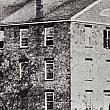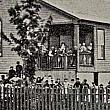
West Side Story
by Diana Barrett
At approximately the same time that the Stone School was constructed on the east side of the river, in 1849, a one-story wooden structure was built in the less populated District No. 2. Shortsighted officials expected this schoolhouse to accommodate the entire West Side school population for the next 100 years.[1] District No. 2, composed of the 4th and 5th wards of the city plus a portion of the town of Walker on the west side of the Grand River, adopted the Union School concept in 1853.
To the surprise of no one, by 1854 it became obvious the first West Side school, the ‘100-year’ school, had been outgrown. Notice of a meeting at the schoolhouse for the taxable inhabitants of District No. 2 appeared in the Enquirer. The purpose of this gathering was to discuss purchasing a lot and erecting a suitable building for a new school. The schoolhouse, occupied for the past four years, stood on leased land and the lease had expired the prior year.
“Now is the accepted time” to make an investment in a site, and it was pointed out that time was of the essence since property values were increasing on the west side of the river. Taxable property within the district was about $200,000. A tax of one and a half mills on the dollar would raise funds sufficient to secure a lot and put up the walls of a two-story stone schoolhouse; the lower part of the building to be finished in time for use in the coming winter.[2]
At a school meeting two weeks later resolutions were unanimously adopted authorizing the purchase of a suitable lot. The committee favored a lot owned by Alderman (get first name) Turner, running from Broadway to Turner Street and a little north of Bridge St., encompassing over an acre of ground. The cost of the lot was $1000 with easy payments offered by Turner. Citizens attending the meeting voted to take the necessary steps to erect a building and to raise $1200 to meet the first payment of $250. The balance was appropriated for the building of a good stone schoolhouse, at a total cost of not less than two to three thousand dollars.
The Daily Enquirer noted,
“Well done No. 2. You have made a commendable beginning. We most heartily approve of the action of the meeting in securing a large lot of ample dimensions for a playground and trust the approaching winter will not set in without finding an abundance of shade trees planted around its borders. Mix up the A B C’s with baseball and pom-pom pull-away; stir up arithmetic, grammar and logic with hop-skip-and-jump, hoop trundling and plenty of exercise and education will be made both attractive and useful and the mind and body correspondingly strengthened.”[3]
The old wooden building would be replaced with one of river limestone, a three-story schoolhouse built at Turner and Broadway. The contract to erect the building was granted to Ebenezer Anderson, a brick and stonemason; Nathaniel Fisk did the joinery work.
The West Side Union School, completed in 1855, accommodated 464 pupils; the rooms had low ceilings and were lighted by small windows. A wooden belfry sheltered the school bell. The third floor, originally used as an armory or drill room by the militiamen, was converted to school use when the number of pupils increased.[4]
In December of 1855 the Enquirer printed the particulars of the new West Side schoolhouse.
“The dimensions are 46 by 67 feet, three stories; the two lower stories are eleven feet each in height, and the upper is thirteen feet. The two lower stories will furnish sufficient accommodations for the present wants of the district, as they will seat nearly 400 scholars.
Each floor is divided into two separate compartments connected with doors; one for the girls and the other for the boys. Each compartment is 32 by 29 ft.; a recitation room, 14 by 16 ft., and a clothes room 7 by 14 ft; and a hall 7½ by 14 ft, and a flight of stairs to the story above. The third story, for the present, will remain in one room and will be used for lecture rooms and like purposes.”[5]
Now Grand Rapids had two Union Schools, one on each side of the Grand River. West-Side residents for many years also referred to their new building as the “Stone School,” a cause for some head scratching by future researchers trying to clarify whether the Stone School or Union School referenced in print belonged on the east or west side of the river. Another similarity between the two schools caused confusion, Rev. James Ballard serving as principal of the east side school from 1850-1853, then becoming principal of the west side school.
Recollections of the West Side Stone School
Charles E. Belknap, who attended the West Side school, described it rather vividly in an essay entitled, “The Stone Schoolhouse.”
“The school was built where the Union High now is. The top, or third floor, was used for the Armory; each lower floor had a large study room and two recitation rooms. In the large room were two box stoves—one on the girls’ and one on the boys’ side of the room—which burned two-foot wood usually carried upstairs by the boys.
The stoves were in one corner of the room and the pipe ran to the other corner overhead, so no heat was lost. When the men drilled in the Armory above, the vibrations parted the pipe joints and the soot sifted down upon the pupils of Prof. Boardman Taylor’s night school.
The Schoolyard, enclosed by a board fence with a post entrance at either corner—not so much to keep the pupils in as to keep the cows and pigs out—was one city block in size except for the home of Mrs. Stephen Cool, who owned two lots at the corner of Turner and Fourth.”[6]
Harlan Colby, a student at the East Side Stone School, added a paragraph to his essay, dated March 8, 1855, about the old West Side schoolhouse and its expected new building.”
“The school on the west side of the river is in a very flourishing condition under Mr. Milton S. Littlefield formerly of Syracuse, New York assisted by Misses Hyde and Chubb. It numbers about 100 pupils with a list constantly increasing. The old hovel now occupied by this school might be supplanted during the coming summer [1855] by a neat brick building, 40 by 70 feet, and two stories in height. A consummation most devoutly to be wished. We can but wish them God-speed.”[7]
[1] Baxter, p 223
[2] Daily Enquirer, 8/16/1854, p 2
[3] Daily Enquirer, 8/30/1854, p2
[4] Baxter, p 223
[5] Daily Enquirer, 12/10/1855, p 2
[6] Belknap, Charles E. The Yesterdays of Grand Rapids. Grand Rapids: Dean-Hicks Co., 1922.
[7] Coll., #013, GR Public Library

 facebook
facebook














